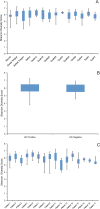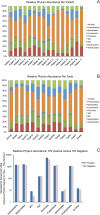The Oral Bacterial Communities of Children with Well-Controlled HIV Infection and without HIV Infection
- PMID: 26146997
- PMCID: PMC4492946
- DOI: 10.1371/journal.pone.0131615
The Oral Bacterial Communities of Children with Well-Controlled HIV Infection and without HIV Infection
Abstract
The oral microbial community (microbiota) plays a critical role in human health and disease. Alterations in the oral microbiota may be associated with disorders such as gingivitis, periodontitis, childhood caries, alveolar osteitis, oral candidiasis and endodontic infections. In the immunosuppressed population, the spectrum of potential oral disease is even broader, encompassing candidiasis, necrotizing gingivitis, parotid gland enlargement, Kaposi's sarcoma, oral warts and other diseases. Here, we used 454 pyrosequencing of bacterial 16S rRNA genes to examine the oral microbiome of saliva, mucosal and tooth samples from HIV-positive and negative children. Patient demographics and clinical characteristics were collected from a cross-section of patients undergoing routine dental care. Multiple specimens from different sampling sites in the mouth were collected for each patient. The goal of the study was to observe the potential diversity of the oral microbiota among individual patients, sample locations, HIV status and various dental characteristics. We found that there were significant differences in the microbiome among the enrolled patients, and between sampling locations. The analysis was complicated by uneven enrollment in the patient cohorts, with only five HIV-negative patients enrolled in the study and by the rapid improvement in the health of HIV-infected children between the time the study was conceived and completed. The generally good oral health of the HIV-negative patients limited the number of dental plaque samples that could be collected. We did not identify significant differences between well-controlled HIV-positive patients and HIV-negative controls, suggesting that well-controlled HIV-positive patients essentially harbor similar oral flora compared to patients without HIV. Nor were significant differences in the oral microbiota identified between different teeth or with different dental characteristics. Additional studies are needed to better characterize the oral microbiome in children and those with poorly-controlled HIV infections.
Conflict of interest statement
Figures





Similar articles
-
Oral microbiome in HIV-associated periodontitis.Medicine (Baltimore). 2017 Mar;96(12):e5821. doi: 10.1097/MD.0000000000005821. Medicine (Baltimore). 2017. PMID: 28328799 Free PMC article.
-
Human immunodeficiency virus and oral microbiota: mutual influence on the establishment of a viral gingival reservoir in individuals under antiretroviral therapy.Front Cell Infect Microbiol. 2024 Apr 10;14:1364002. doi: 10.3389/fcimb.2024.1364002. eCollection 2024. Front Cell Infect Microbiol. 2024. PMID: 38660490 Free PMC article. Review.
-
Oral microbiome composition changes in mouse models of colitis.J Gastroenterol Hepatol. 2015 Mar;30(3):521-7. doi: 10.1111/jgh.12713. J Gastroenterol Hepatol. 2015. PMID: 25180790
-
Oral microbiota in youth with perinatally acquired HIV infection.Microbiome. 2018 May 31;6(1):100. doi: 10.1186/s40168-018-0484-6. Microbiome. 2018. PMID: 29855347 Free PMC article.
-
The oral microbiome and human health.J Oral Sci. 2017;59(2):201-206. doi: 10.2334/josnusd.16-0856. J Oral Sci. 2017. PMID: 28637979 Review.
Cited by
-
Oral microbiome in HIV-associated periodontitis.Medicine (Baltimore). 2017 Mar;96(12):e5821. doi: 10.1097/MD.0000000000005821. Medicine (Baltimore). 2017. PMID: 28328799 Free PMC article.
-
Impact of HIV on the Oral Microbiome of Children Living in Sub-Saharan Africa, Determined by Using an rpoC Gene Fragment Metataxonomic Approach.Microbiol Spectr. 2023 Aug 17;11(4):e0087123. doi: 10.1128/spectrum.00871-23. Epub 2023 Jul 10. Microbiol Spectr. 2023. PMID: 37428077 Free PMC article.
-
Independent Effects of HIV and Antiretroviral Therapy on the Oral Microbiome Identified by Multivariate Analyses.mBio. 2023 Jun 27;14(3):e0040923. doi: 10.1128/mbio.00409-23. Epub 2023 Apr 18. mBio. 2023. PMID: 37071004 Free PMC article.
-
Human immunodeficiency virus and oral microbiota: mutual influence on the establishment of a viral gingival reservoir in individuals under antiretroviral therapy.Front Cell Infect Microbiol. 2024 Apr 10;14:1364002. doi: 10.3389/fcimb.2024.1364002. eCollection 2024. Front Cell Infect Microbiol. 2024. PMID: 38660490 Free PMC article. Review.
-
Interplay between oral immunity in HIV and the microbiome.Oral Dis. 2020 Sep;26 Suppl 1(Suppl 1):59-68. doi: 10.1111/odi.13515. Oral Dis. 2020. PMID: 32862522 Free PMC article.
References
-
- Ramberg PW, Lindhe J, Gaffar A. Plaque and gingivitis in the deciduous and permanent dentition. J Clin Periodontol. 1994;21(7):490–6. Epub 1994/08/01. . - PubMed
-
- Beck JD, Arbes SIj. Epidemiology of gingival and periodontal disease In: Newman MG, Taki HH, Klokkevold PR, Carranza F, editors. Carranza's Clinical Periodontology. 10th ed. St. Louis: Saunders Elsevier; 2006. p. 117–9.
Publication types
MeSH terms
Substances
Associated data
Grants and funding
LinkOut - more resources
Full Text Sources
Other Literature Sources
Medical

